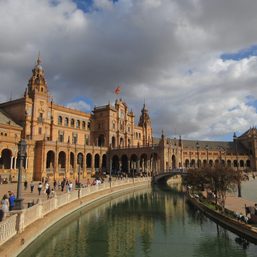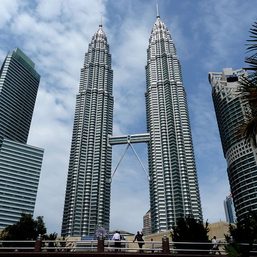SUMMARY
This is AI generated summarization, which may have errors. For context, always refer to the full article.

Barcelona is a popular tourist destination for good reason. It has historic attractions, rich culture, great dining options, its own football team (FC Barcelona), a beach, and a nice, laid-back vibe. This bustling metropolis along the coast is the capital and largest city in autonomous Catalonia, with an architectural aesthetic influenced by Antoni Gaudi.
I visited Barcelona as part of a trip to different countries in Europe, and here are my tips for traveling there.
Getting a visa
Spain is one of the Schengen zone countries, which means that if you get a visa from one of these countries, then you can travel to all of its member states. I got my Schengen visa from the Austrian Embassy and included Spain in my itinerary. Most Schengen countries course their visa application through VFS in the Philippines.
However, Spain implements its own process and uses its own system. If Spain is your main destination, visit this website to book an appointment. The requirements are like other Schengen visa applications (bank statements, certificate of employment, pay slips, business registration, etc.).

Entering Barcelona
I entered Barcelona, Spain by plane from Budapest, Hungary during my trip around Europe. El Prat is their main airport. Many airlines fly into and out of this airport, including Wizz Air and Ryan Air (low-cost airlines). Look for affordable plane tickets through various apps, site aggregators, or directly from airlines.
You can take public transportation from the airport to the city center.
By metro
It’s a long walk from the arrival terminals to the metro, but it’s manageable. There are signs that lead to the airport metro station, so you won’t get lost. Metro line L9 Sud (airport) is connected to metro lines in different parts of the city such as Can Tries | Gornal Station in L10, Collblanc Station in L5, Torrassa Station in L1, and Zona Universitaria in L3. A single ticket costs €5.15.
By bus
AEROBUS travels from the airport to the city center and vice-versa. A one-way ticket costs €5.90.
If you’re arriving from Madrid, there are multiple bus and train services that travel to Barcelona. You can check this site for train and bus schedules.

Getting around Barcelona
Barcelona is pedestrian-friendly and offers visitors a variety of public transportation options. You can take the tram or bus, rent a bike, take a taxi, or my go-to option, which is ride the subway. The city has an extensive subway network, and stations are often within walking distance to attractions. There are 24, 28, 72, 96, and 120-hour passes. I bought a 24-hour pass for €10.50 and a 48-hour pass for €16.40 from one of the machines in the metro station.
Itinerary and places to visit
Barcelona is an easy city to explore. Most of the attractions are within walking distance of each other. A few are bit further out of the city center but still accessible by public transportation. It’s possible to pack in the major sites of the city in one or two days. However, you’d be rushing through at that pace. It’s recommended to at least spend four days in the city, but it wouldn’t be surprising if you decided to stay longer than that.
This itinerary assumes you’ll start with one full day.
Day 1

Start your first day in Barcelona by visiting Gaudi’s most famous works and seeing the city’s beautiful architecture. The area you’d want to explore first is Eixample. The latter is an expansion of the old city when it experienced an increase in population in the 19th century. Urban planners at the time conceived and implement a grid-like neighborhood that connected the old town with the surrounding villages. Fast forward to today, the area is filled with some of the city’s most beautiful architecture, restaurants, bars, cafés, and shops. This is where you’ll find the striking Casa Batllo, Casa Amatller, Casa Lleo Morera, and the Casa Mila.

The Casa Batllo is one of Gaudi’s acclaimed works. Its distinct look draws the attention of all who sees it. The wavy patterns, colorful mosaics, and bone-like balconies all make for a beautiful and unique façade. The Batllo family hired Gaudi to design the house in 1904. Another of Gaudi’s works is the nearby Casa Mila. Also known as La Pedrera, Casa Mila’s construction took place between 1906 and 1912. Gaudi remained true to form with the building’s distinct, undulating appearance. At the time of its completion, many have criticized and mocked the building because it didn’t follow any design conventions.

After exploring Eixample and having a bite, make your way to the most well-known destination in Barcelona, the Sagrada Familia. Work on the Sagrada began in 1882 and has yet to be finished decades after the death of Antoni Gaudi. Gaudi, a devout Catholic, dedicated his life to the design, planning, and construction of the Sagrada. He drew inspiration from nature and implemented it in his work. He used curves, tree-inspired columns, arches, etc. If you look closely at one of the façades, the carvings and mini statues depict the life of Jesus, while the other façade depicts the crucifixion of Jesus. The inside of the church is just as spectacular as the outside. It’s something better off seen than simply described. If you were to pay for just one attraction during your stay in the city, the Sagrada should be it. Try to return at night to see the church lit up.

*The Casa Batllo, Casa Mila, and Sagrada Familia are all UNESCO World Heritage sites.
Entrance fees:
- Casa Battlo – €35
- Casa Mila – €25
- Sagrada – €26

Day 2
After eating breakfast at your chosen café or restaurant, or at your accommodation, start your second full day in Barcelona with a stop at the Placa de Catalunya. Walk there from either the Universitat or the Urquinaona metro stations, or from your accommodation if you’re near enough. Placa de Catalunya is a favorite meeting place of both locals and tourists because of its central location. It is walking distance from many attractions and nearby metro stations. This area is surrounded by shops, restaurants, sculptures, and beautiful buildings. It’s the area that bridges the old town with the Eixample. Go window shopping (or actual shopping), take photos, and soak in the bustling energy.
Make your way to the Palau de la Musica Catalana, a UNESCO World Heritage Site. This destination is another architectural wonder of the city, designed by Lluis Domenech i Montaner. It follows the Catalan modernista style which was famous at the time. This concert hall was constructed between 1905-1908.
After your stop at the beautiful concert hall, walk to the Barcelona Cathedral near Barri Gotic. The Barcelona Cathedral (or the Cathedral of Santa Eulalia) was built between the 13th to 15th centuries. Its fetching neo-Gothic façade was built over the old exterior some time in the 19th century.

The Barcelona Cathedral is near the famous and beautiful Gothic Quarter or Barri Gotic. This area covers some of the city’s oldest parts. Contrary to its name, a substantial part of the neighborhood dates only to the 19th and early 20th centuries. Restoration projects have turned the Gothic Quarter into a tourist-friendly destination without taking away its medieval charm. Weave in and out of the narrow alleys and roads to find yourself in plazas and churches. There are many cafés, shops, and restaurants in this area. You may already be hungry after all that walking.

If you can’t decide on a place to eat, make your way to another famous area in Barcelona, the La Rambla. The latter is a walking street lined with more places to eat and shop; you can find fast food chains and local restaurants here. You can also check out the Mercado de la Boqueria. The latter is a famous market where you can try all sorts of food. You can spend the remainder of the day hanging out and/or eating in the Gothic Quarter.

Entrance fees:
- Palau de la Musica Catalana – €14 including audio guide
- Barcelona Cathedral – €9
- Palau Guell – €12
Day 3
After a packed two days of walking around Barcelona’s touristy neighborhoods and pedestrian streets, spend a few hours in Parc Guell. The park contains some of Gaudi’s surreal works. It also has gardens and beautiful overlooking views of the city. Follow the crowds to the most famous view of the park, the mosaics on the terrace and the two buildings designed by Gaudi. The park is perched on a hill which provide it with a bird’s eye views of Barcelona. I did a bit of exploring to find the best spots. From one of the viewpoints, you’ll see how massive the Sagrada is compared to the rest of the buildings in the city. You’ll immediately recognize its spires and distinct architecture from above. The park is quite far from the city center, so you’d have to take the bus or the metro to reach it.
After spending a few hours in the park, make your way to the other end of the city in La Barceloneta. This beach area still had a few groups of people hanging out even during the winter. I could imagine it packed with locals and tourists alike during the warmer months of the summer. From the beach, you can see a sail-like building in the distance – this is the Hotel W Barcelona. Explore the nearby neighborhood and dock. You can also find some restaurants and bars here. Some other attractions in the area are the Rambla de Mar, Aquarium Barcelona, Maritime Museum, and the Museu d’Historia de Catalunya. Watch the sunset by the beach and eat somewhere nearby or make your way back to La Rambla or the Gothic Quarter.

Entrance fees:
- Maritime Museum – €10 (adults), €5 (children 7-16 years old)
- Museu d’Historia de Catalunya – €6
- Aquarium Barcelona – €24 (adults), €17 (5-10 years old), €10 (3-4 years old)
- Parc Guell – €10 (general ticket), €7 (7-12 years old)
Day 4
Spend your fourth day relaxing and taking easy walks around the city. Barcelona offers a mix of energy and a laid-back vibe. Meals start late. Eat some more paella, have another glass of beer or wine, eat churros, and eat croquetas. There are also several bars and clubs that cater to various genres, from jazz to techno to hip-hop to pop. Whatever kind of fun you want to have, the city has it.

Other places you might want to visit:
- Camp Nou (for football fans)
- Parc de Montjuic
- Day trip to Montserrat Monastery
- Day trip to Girona
Four days covers the main tourist destinations and gives you a relaxed pace to discover and experience Barcelona. You could easily spend a week or longer in this city.
How much will you spend?
€55 a day is possible during your stay in Barcelona. However, this limits the number of attractions you visit and reduces your choices when it comes to eating out. You’ll also be staying in a hostel dorm and taking public transportation or walking often with this budget. I only ate out a couple of times in restaurants. The most expensive meal I had was €40+++, but I split the bill with another person (I paid €20), and only did this once. I also paid for just two attractions: the Sagrada and Parc Guell. Hang out by the beach (even in the winter), get a beer or wine in the afternoon, and linger in the Latin Quarter or one of the plazas. This budget is the lower limit; you can spend more depending on what you do, where you eat, where you stay, if you go on a day trip, and how you explore the city.

Money-saving tips
- If you’re traveling alone, consider staying in a dorm room. Read reviews and browse pictures if the hostel you have in mind meets your needs. The extra money you save on accommodation allows you to spend more on other things during your stay in the city.
- Buy a multi-day pass for the buses, trams, and subway. You get good value for the ticket and reduce the time spent walking to attractions in the city.
- Barcelona is a pedestrian-friendly city. Walking from one attraction to the next allows you to experience the city and see more of it.
- Consider buying food from groceries, supermarkets, sandwich shops, and bakeries. There are packed meals you can heat and sandwiches that are filling. You can also buy food and cook, if your accommodation allows it.
- It’s possible to enter the Sagrada for free during special occasions and on Sundays. However, everybody wants to enter for free. You need to plan your trip to be within a special occasion or over the weekend. Mass often starts at around 9 am. Try to go as early as possible to get inside because slots for the free entrance are limited.
- Consider traveling during shoulder season or winter, prices are generally lower during these times.
- Join a free walking tour to learn more about the city through a local’s eyes. You can tip the guide after the tour. The amount will be up to you.
– Rappler.com
Joshua Berida is a writer who loves to travel. He blogs at www.thewanderingjuan.net.
Traveling to Europe soon? Book flights and hotels using this Agoda promo code.
Add a comment
How does this make you feel?





There are no comments yet. Add your comment to start the conversation.